5 Steps on How to Build a Agent AI That Reply with Voice
Discover how to build a agent AI that replies with voice for enhanced user interaction and satisfaction.

Key Highlights:
- Define the agent's purpose by identifying specific tasks, target audience, and issues it aims to resolve.
- Select core technologies including Automatic Speech Recognition (ASR), Natural Language Processing (NLP), and Text-to-Speech (TTS) for optimal performance.
- Design the voice conversation flow with key interactions: welcome message, intent recognition, response generation, and error handling.
- Train the voice AI agent using contextual data to improve understanding of diverse speech patterns and enhance effectiveness.
- Integrate the agent with existing systems and conduct functional testing to ensure reliable performance.
- User Acceptance Testing (UAT) is crucial for gathering feedback and improving user experience.
- Continuously monitor and optimise the agent's performance post-deployment to enhance engagement and satisfaction.
Introduction
Crafting a voice AI agent that engages users through natural conversation is no small feat. Yet, the demand for such technology is surging as businesses seek to enhance customer interactions. This guide outlines a structured approach to building an effective voice AI agent—from defining its purpose to integrating advanced technologies like:
- Automatic Speech Recognition
- Natural Language Processing
- Text-to-Speech
As organisations embark on this journey, they often grapple with challenges in ensuring seamless integration and user satisfaction. What pivotal steps can transform an idea into a successful voice AI solution?
Define the Purpose and Use Case for Your Voice AI Agent
To begin, ascertain how to build an agent AI that replies with voice to serve your primary purpose. Consider the following critical questions:
- What specific tasks will the agent perform? (e.g., customer support, personal assistant, etc.)
- Who is the target audience? (e.g., businesses, consumers, etc.)
- What issues does the representative aim to resolve?
Meticulously document these insights to establish a clear use case that will guide your design and development process, particularly in how to build an agent AI that replies with voice. For example, if your representative is tailored for customer service, delineate the types of inquiries it should handle and the expected outcomes.
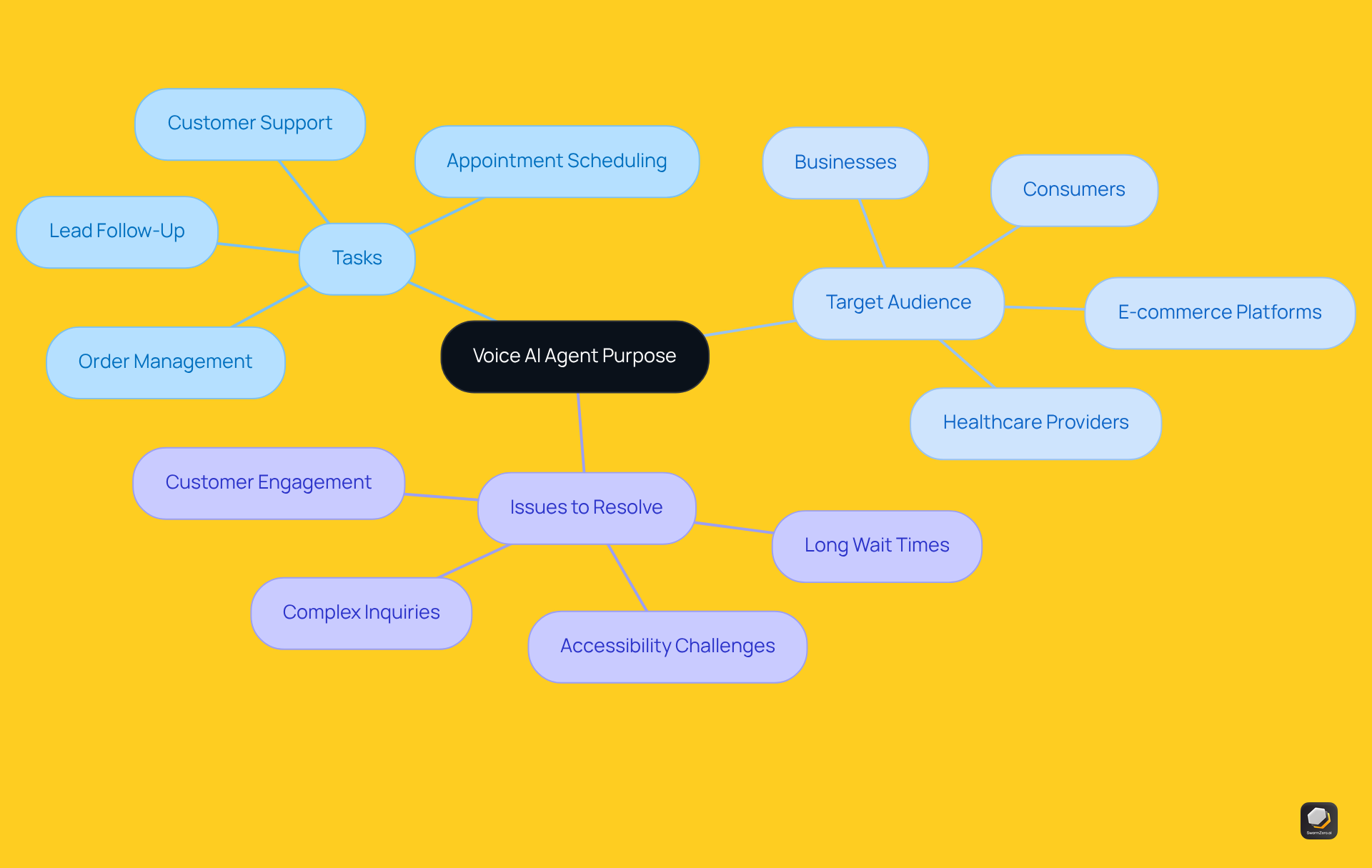
Select the Core Technology Stack: ASR, NLP, and TTS
Selecting the right core technologies is crucial for achieving optimal performance when learning how to build an agent AI that replies with voice. The primary components to consider include:
-
Automatic Speech Recognition (ASR): This technology converts spoken language into text, enabling the system to understand user input. Choosing a reliable ASR service that supports multiple languages and accents is essential, as accuracy in diverse linguistic contexts is vital. Recent advancements in ASR technology have significantly enhanced recognition capabilities, establishing it as a foundational element in audio AI solutions. The speech and voice recognition market is projected to reach USD 81.59 billion by 2032, underscoring the growing importance of ASR across various applications.
-
Natural Language Processing (NLP): Once spoken input is transformed into text, NLP analyses this text to comprehend intent. Selecting an NLP framework capable of managing the complexity of your specific use case is critical. The latest NLP frameworks employ deep learning methods to improve context understanding, facilitating more meaningful interactions between individuals and AI systems. As noted by Cole Stryker, "NLP enhances data analysis by enabling the extraction of insights from unstructured text data, such as customer reviews and social media posts."
-
Text-to-Speech (TTS): This technology converts text back into spoken language, allowing the AI agent to respond audibly. Opt for a TTS engine that provides natural-sounding speech and supports multiple languages to ensure a pleasant experience for the user. The integration of advanced TTS systems can greatly enhance engagement by demonstrating how to build an agent AI that replies with voice for a more human-like exchange. Successful implementations, such as AI-driven recommendations in e-commerce, have resulted in a 20% increase in conversion rates, demonstrating the effectiveness of these technologies.
Researching and comparing various providers for ASR, NLP, and TTS technologies will enable you to find the best fit for your project requirements. Successful implementations of audio AI technology stacks have shown that a carefully selected mix of these technologies can lead to enhanced customer satisfaction and operational efficiency.
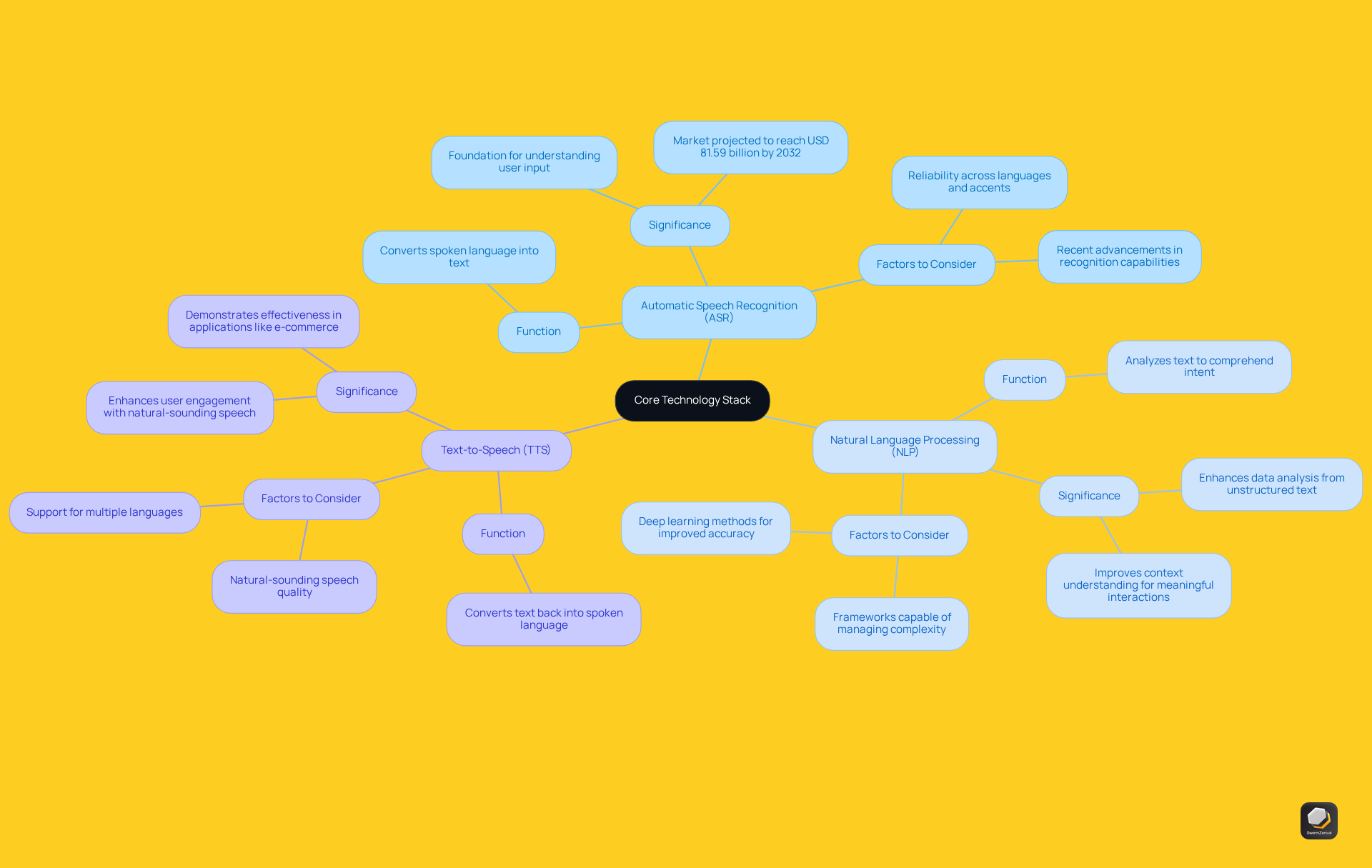
Design the Voice Conversation Flow
To effectively design the voice conversation flow for your AI agent, begin by outlining the key interactions it will have:
- Welcome: Create a friendly and inviting introduction that sets a positive tone for the engagement, making individuals feel embraced.
- Participant Intent Recognition: Develop prompts that encourage individuals to express their requirements clearly. This step is vital; efficient intent recognition can significantly boost engagement success rates. Research indicates that well-crafted prompts enhance clarity in 65% of instances. Furthermore, 65% of all customer interactions can now effectively be conducted by AI-powered chatbots, emphasising the efficiency of AI in customer interactions.
- Response Generation: Strategise how the agent will react to various inputs from individuals. This includes preparing for follow-up questions and clarifications, ensuring that responses remain relevant and helpful.
- Error Handling: Formulate robust strategies for addressing misunderstandings or incorrect inputs. This may involve providing rephrasing options or alternative suggestions, which can help sustain engagement and satisfaction.
Utilising flowcharts or conversation design tools, such as Voiceflow, can assist in visualising these pathways, ensuring a logical and user-friendly progression. By concentrating on these aspects, you can discover how to build an AI agent that replies with voice, which not only meets user expectations but also enhances overall communication quality. Moreover, with 89% of customers favouring brands that provide audio AI support, understanding how to build an AI agent that replies with voice is crucial for remaining competitive. As AI usage continues to rise, with forecasts that 85% of businesses will embrace AI systems by 2025, the necessity for efficient auditory communication design grows even more essential.
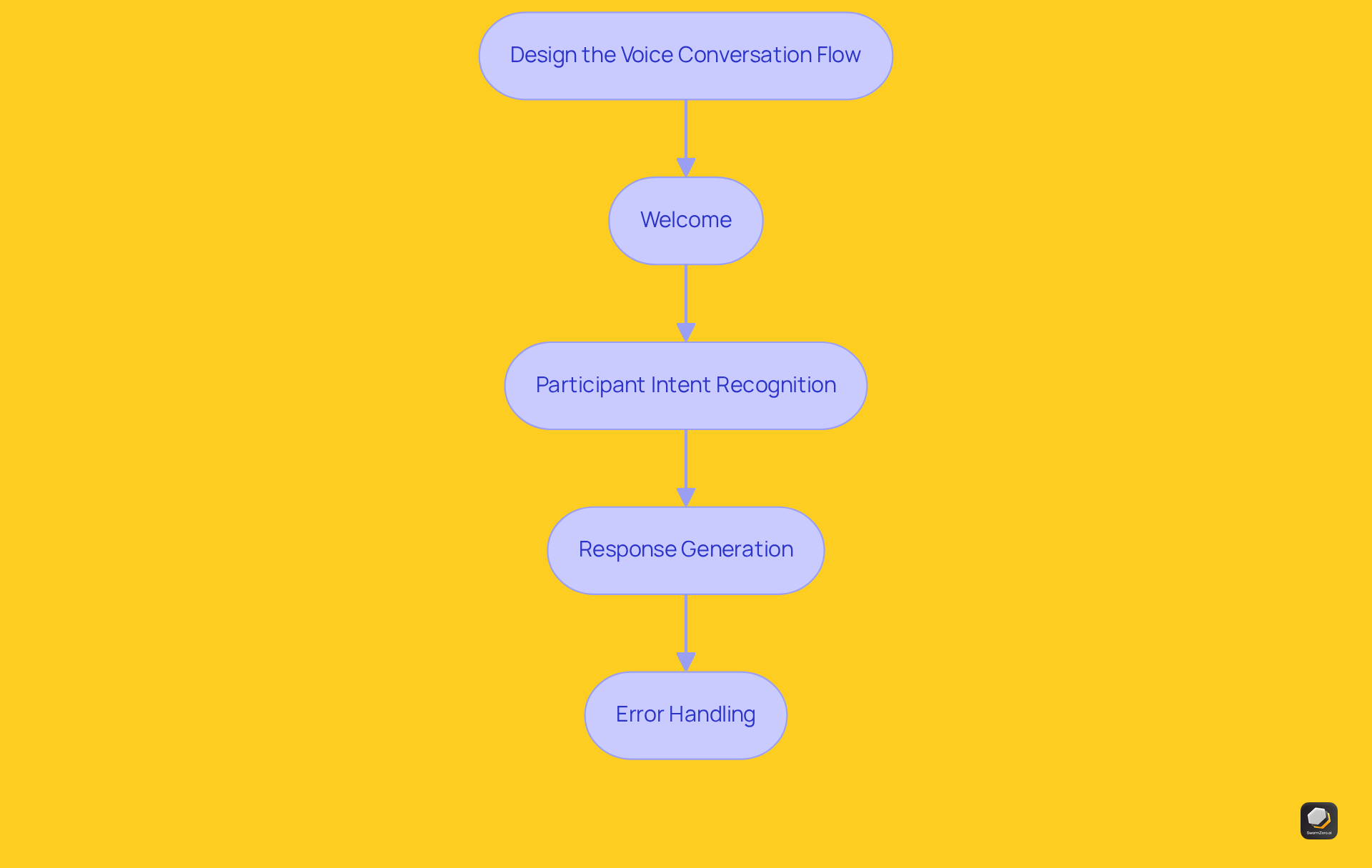
Train Your Voice AI Agent with Contextual Data
To effectively train your voice AI agent, adhere to the following steps:
- Gather Contextual Data: Collect data that mirrors real user interactions, incorporating a variety of accents, dialects, and speech patterns. This diversity is crucial, as it enables the AI to understand and respond accurately to a wide range of user inputs.
- Fine-Tune the Model: Utilise the gathered data to refine the AI model. This step ensures that the representative can identify and suitably react to the subtleties of various speech styles and situations, thereby enhancing its overall effectiveness.
- Test and Iterate: Continuously evaluate the system's performance using new data. Consistent testing and iteration based on feedback and usage logs are essential for recognising areas for enhancement. This iterative process allows the individual to learn and adapt, significantly improving its ability to handle complex queries over time.
By emphasising contextual information in your training method, you can discover how to build an AI agent that replies with voice, allowing the AI system to meet user expectations and adapt to manage increasingly complex interactions.
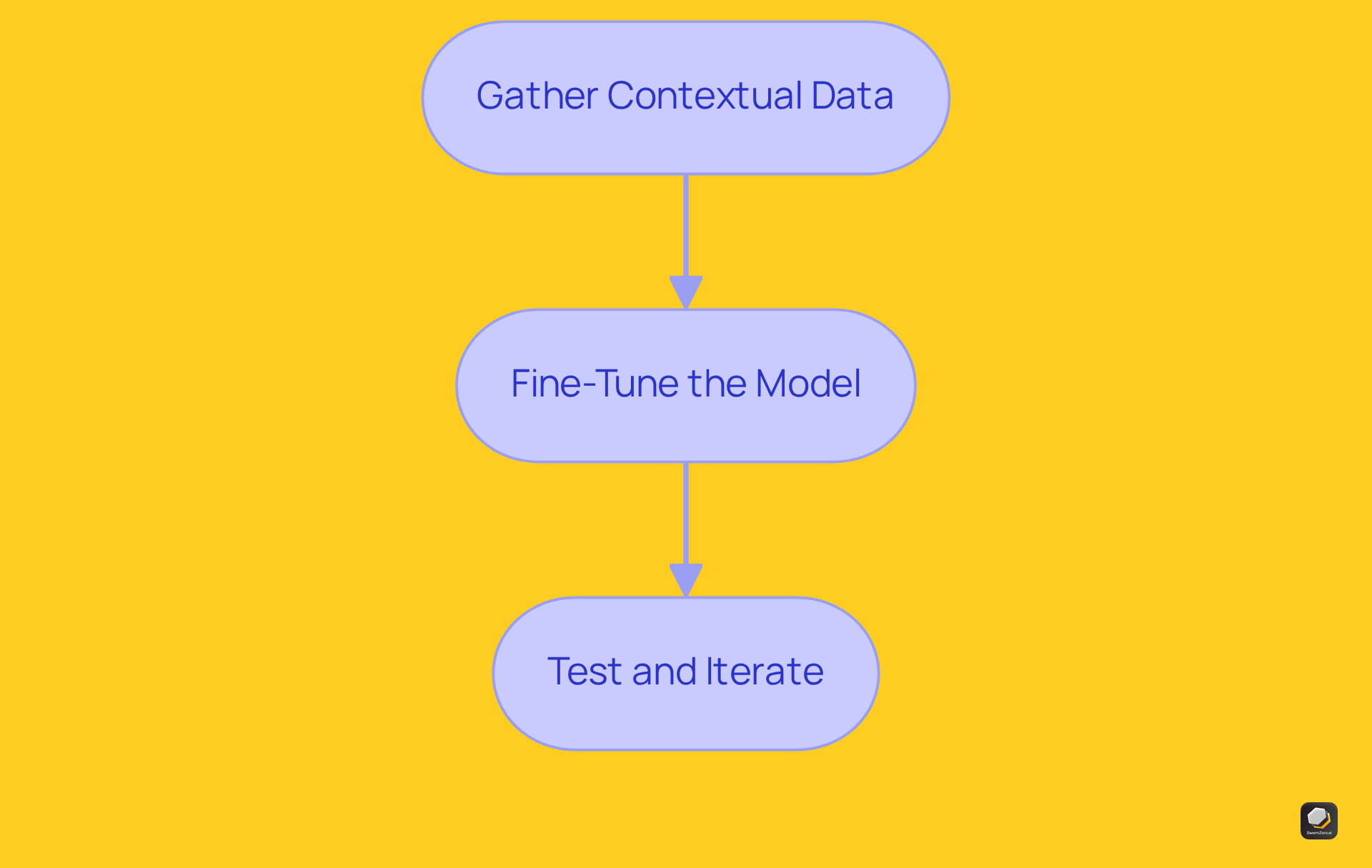
Integrate and Test Your Voice AI Agent
Once your voice AI agent is developed, it is imperative to follow these essential steps for integration and testing:
- Integrate with Existing Systems: Ensure the system can seamlessly connect with necessary APIs, databases, and other tools to access real-time information. Successful API integration is crucial; studies show that organisations leveraging effective integration strategies see a 30% improvement in operational efficiency (source: AI Integration in Manufacturing).
- Conduct Functional Testing: Implement rigorous functional testing to assess the system's responses to various inputs. This testing should encompass a variety of scenarios, including edge cases, to ensure the system performs as anticipated. Data indicates that comprehensive functional testing can reduce post-deployment issues by up to 40% (source: Comprehensive Testing and Evaluation).
- User Acceptance Testing (UAT): Involve actual participants in the testing process to collect valuable feedback on the system's performance and usability. UAT is essential for identifying experience issues, with case studies demonstrating that organisations prioritising feedback during testing achieve a 31.5% increase in customer satisfaction scores (source: Customer Satisfaction Boost from AI).
- Monitor and Optimise: After deployment, continuously observe the system's interactions and performance metrics. Utilise analytics tools to track success rates and identify areas for improvement. Organisations applying continuous optimisation strategies report significant enhancements in participant engagement over time (source: Continuous Evaluation Practises).
This comprehensive testing approach will ensure that your understanding of how to build a AI agent that reply with voice is well-prepared for real-world use, enhancing both functionality and user satisfaction.
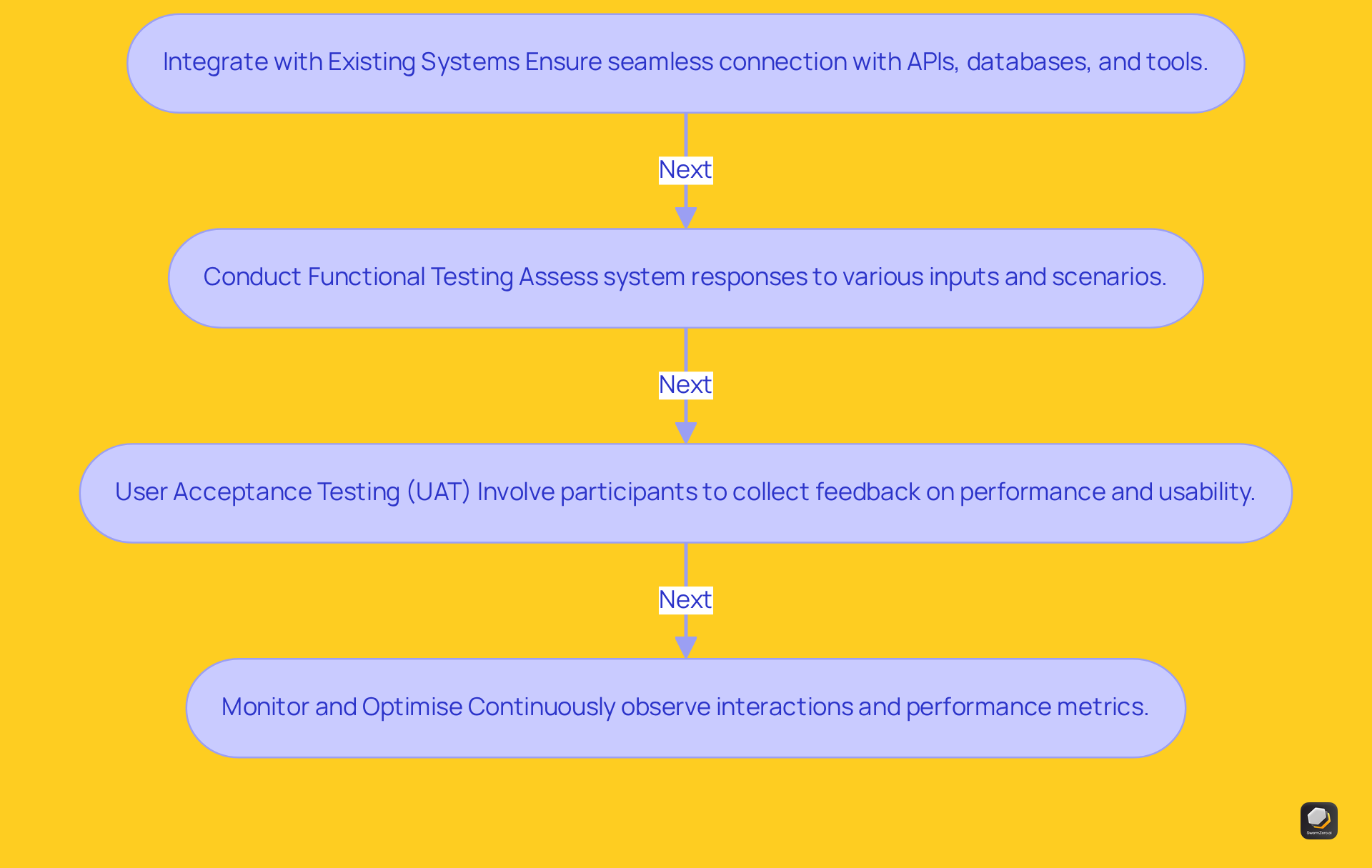
Conclusion
Building a voice AI agent necessitates a strategic approach that encompasses defining its purpose, selecting the right technologies, designing conversation flows, training with context, and conducting thorough integration and testing. The central idea focuses on creating an effective voice AI that not only meets user needs but also enhances engagement through natural interactions.
The article outlines critical steps, including:
- Identifying the agent's specific tasks and target audience
- Choosing core technologies such as ASR, NLP, and TTS
- Establishing a logical conversation flow
Furthermore, the significance of contextual data in training the AI and the necessity of rigorous testing to ensure functionality and user satisfaction are emphasised. Each of these elements plays a vital role in developing a voice AI that is responsive, accurate, and user-friendly.
In conclusion, as the demand for voice AI technology continues to rise, understanding how to build an effective voice agent becomes increasingly essential. Embracing these best practises positions developers to create superior voice interactions and empowers businesses to leverage AI for enhanced customer experiences. Now is the time to invest in voice AI development, ensuring that the solutions created are not just functional but also resonate with users in a meaningful way.
Frequently Asked Questions
What is the first step in building a voice AI agent?
The first step is to define the purpose and use case for the voice AI agent by determining specific tasks it will perform, identifying the target audience, and understanding the issues it aims to resolve.
Why is it important to document insights during the planning phase?
Documenting insights helps establish a clear use case that guides the design and development process, ensuring that the voice AI agent effectively addresses the intended tasks and outcomes.
What core technologies are essential for a voice AI agent?
The core technologies essential for a voice AI agent include Automatic Speech Recognition (ASR), Natural Language Processing (NLP), and Text-to-Speech (TTS).
What role does Automatic Speech Recognition (ASR) play in voice AI?
ASR converts spoken language into text, enabling the system to understand user input. It is crucial to choose a reliable ASR service that supports multiple languages and accents for accurate recognition.
How does Natural Language Processing (NLP) contribute to voice AI?
NLP analyses the text generated by ASR to comprehend the user's intent, facilitating meaningful interactions between individuals and AI systems through advanced deep learning methods.
What is the function of Text-to-Speech (TTS) technology in a voice AI agent?
TTS converts text back into spoken language, allowing the AI agent to respond audibly. A good TTS engine should provide natural-sounding speech and support multiple languages for a better user experience.
How can the choice of ASR, NLP, and TTS technologies impact the performance of a voice AI agent?
The right mix of ASR, NLP, and TTS technologies can lead to enhanced customer satisfaction and operational efficiency, as successful implementations have shown significant improvements in engagement and conversion rates.
What should one consider when selecting providers for ASR, NLP, and TTS technologies?
It is important to research and compare various providers to find the best fit for your project requirements, ensuring that the selected technologies align with the specific use case of the voice AI agent.
List of Sources
- Define the Purpose and Use Case for Your Voice AI Agent
- 59 AI customer service statistics for 2025 (https://zendesk.com/blog/ai-customer-service-statistics)
- 61 AI Customer Service Statistics in 2025 (https://desk365.io/blog/ai-customer-service-statistics)
- AI Voice Agents Are Fooling Customers, And It’s Working Better Than Expected (https://forbes.com/sites/rogerdooley/2025/06/06/ai-voice-agents-are-fooling-customers-and-its-working-better-than-expected)
- 30+ Voice AI Stats for 2025 (https://verloop.io/blog/voice-ai-statistics)
- How To Build a Voice AI Agent in 2025 (Complete Guide) (https://raftlabs.com/blog/complete-guide-to-ai-voice-agents)
- Select the Core Technology Stack: ASR, NLP, and TTS
- Speech Recognition Explained in 10 Different Expert Quotes (https://transcribeme.com/blog/blog-speech-recognition-explained-in-quotes)
- Advanced Chatbot Design for Enhanced User Interactions (https://moldstud.com/articles/p-advanced-chatbot-design-for-enhanced-user-interactions)
- Automated speech recognition system shows promise for making language testing more accessible and scalable (https://phys.org/news/2025-04-automated-speech-recognition-language-accessible.html)
- What Is NLP (Natural Language Processing)? | IBM (https://ibm.com/think/topics/natural-language-processing)
- Speech and Voice Recognition Market Size, Share, Growth, 2032 (https://fortunebusinessinsights.com/industry-reports/speech-and-voice-recognition-market-101382)
- Design the Voice Conversation Flow
- Conversational Design - Voiceflow blog category (https://voiceflow.com/blog-category/conversational-design)
- AI Voice Agents Are Fooling Customers, And It’s Working Better Than Expected (https://forbes.com/sites/rogerdooley/2025/06/06/ai-voice-agents-are-fooling-customers-and-its-working-better-than-expected)
- project case studies: Topics by Science.gov (https://science.gov/topicpages/p/project+case+studies.html)
- 30+ Voice AI Stats for 2025 (https://verloop.io/blog/voice-ai-statistics)
- AI Agents Statistics: Usage And Market Insights (https://litslink.com/blog/ai-agent-statistics)
- Train Your Voice AI Agent with Contextual Data
- Aircall launches AI Voice Agent | Aircall (https://aircall.io/blog/news/aircall-launches-ai-voice-agent)
- How to Build an AI Voice Agent: Step-by-Step Guide for 2025 (https://biz4group.com/blog/how-to-build-an-ai-voice-agent)
- What Is An AI Voice Agent and How To Build One? | Astera (https://astera.com/type/blog/ai-voice-agent)
- 30+ Voice AI Stats for 2025 (https://verloop.io/blog/voice-ai-statistics)
- Using Voice AI to Increase First Contact Resolution (FCR) (https://kommunicate.io/blog/how-voice-ai-boosts-fcr)
- Integrate and Test Your Voice AI Agent
- Testing & Evaluating Voice Agents with Inya.ai: A Practical Guide (https://gnani.ai/resources/blogs/testing-evaluating-voice-agents-with-inya-ai-a-practical-guide)
- 30+ Powerful AI Agents Statistics In 2025: Adoption & Insights (https://warmly.ai/p/blog/ai-agents-statistics)
- AI Agent Statistics for 2025: Adoption, ROI, Performance & More (https://plivo.com/blog/ai-agents-top-statistics)
- 150+ AI Agent Statistics [July 2025] (https://masterofcode.com/blog/ai-agent-statistics)
- 80+ AI Agent Usage Stats for 2025 | Zebracat (https://zebracat.ai/post/ai-agent-usage-statistics)




